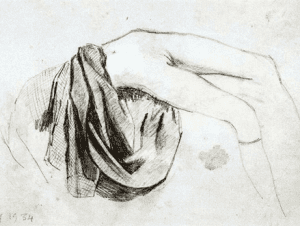Stepping into the world of Johannes Vermeer, one of history’s greatest painters, is like entering a realm of mesmerising beauty and captivating storytelling. On the final day of the Vermeer exhibition at the renowned Rijksmuseum in Amsterdam, I had the privilege of securing two coveted tickets through a thrilling lottery-based event. Join me as I recount this extraordinary night, filled with enchantment, artistic mastery, and a deep appreciation for Vermeer’s timeless works.
The Unveiling of Vermeer’s Masterpieces
As I eagerly entered the Vermeer exhibition at the Rijksmuseum, a palpable sense of excitement buzzing with anticipation filled the air. The exhibition’s highly anticipated display of Vermeer’s masterpieces had drawn crowds from near and far, and securing tickets for this exclusive event was an accomplishment in itself. The moment the doors swung open, I stepped into a world where time seemed to stand still.
The exhibition’s curators had carefully selected an extraordinary collection of Vermeer’s paintings, showcasing his unparalleled talent and artistic vision.
Moving through the exhibition, I encountered Vermeer’s iconic works, each one unveiling a new layer of his artistic genius. “The Milkmaid” captivated me with its meticulous attention to detail, from the delicate folds of the maid’s dress to the gleaming earthenware pitcher. The play of light on the subject’s face and the meticulously rendered textures transported me to the bustling Dutch household of the 17th century. As I stood before the iconic painting “The Milkmaid” by Johannes Vermeer, a sense of awe washed over me. The serene atmosphere of the gallery seemed to melt away as my gaze fixed on this masterpiece. It was as if time stood still, and I found myself captivated by the quiet beauty and intimate simplicity of the scene.
The delicate brushstrokes, meticulously capturing every detail, brought the milkmaid to life before my eyes. The warm hues of ochre, brown, and blue infused the painting with a sense of warmth and cosiness. The play of light and shadow enhanced the depth and texture of the image, creating a sense of tactile realism.
The milkmaid herself became the focal point of my attention. Her graceful posture and focused expression revealed a sense of purpose and concentration. With one hand pouring milk and the other gripping a jug, she seemed to embody the dignity and quiet strength of everyday labour.
I marvelled at Vermeer’s ability to elevate the mundane into the realm of art. The humble act of pouring milk was transformed into a moment of transcendent beauty. It was as if Vermeer had frozen time, capturing the essence of this simple act and imbuing it with a profound sense of significance.
As I studied the painting, I found myself drawn into the world it depicted. I could almost hear the faint sound of the pouring milk and feel the coolness of the kitchen. The painting evoked a sense of nostalgia and familiarity, evoking memories of domesticity and the quiet routines of daily life.
One painting that particularly stood out was “View of Delft.” Its grandeur and intricate depiction of the cityscape left me in awe. Vermeer’s ability to capture the essence of a place and to render the reflection of light on the water and the architectural details with such precision showcased his extraordinary talent and his keen eye for capturing the beauty of his surroundings.
Each painting in the exhibition was carefully displayed, allowing visitors to fully immerse themselves in Vermeer’s world. The lighting was expertly calibrated to accentuate the nuances of colour and texture, revealing the intricacies of Vermeer’s brushwork and his mastery of light and shadow, with each room we entered matched to a colour scheme of the world renowned paintings and his mastery of light and shadow, with each room we entered matched to a colour scheme of the world-renowned paintings. The sheer depth and clarity of the paintings evoked a sense of timelessness, drawing me further into Vermeer’s artistic universe.
The unveiling of Vermeer’s masterpieces at the Rijksmuseum was a testament to the enduring power of his art. Standing in the presence of these iconic works, I felt a deep connection to the artist’s vision and an appreciation for his unwavering dedication to his craft. Vermeer’s ability to capture fleeting moments of beauty, infuse ordinary scenes with extraordinary depth, and transport viewers to another time and place is a testament to his status as a true master of the Golden Age of Dutch painting.
In the presence of Vermeer’s paintings, time seemed to lose its grip, and I found myself captivated by the subtle details, the delicate interplay of light and shadow, and the profound stories that unfolded within each canvas. The experience was a reminder of the enduring power of art to transcend time, culture, and generations, touching our souls and inspiring us to see the world through a different lens.
The Magic of Nighttime Viewing
Experiencing the Vermeer Exhibition at night added an extra layer of enchantment and intrigue to an already extraordinary event. As daylight waned and the museum’s lights softly illuminated the gallery, a sense of anticipation filled the air. The shift from the bustling daytime atmosphere to the serene ambiance of nighttime created a unique and intimate setting for the masterpieces to come alive.
As I entered the exhibition hall, a hushed reverence seemed to settle among the visitors. The soft glow of strategically placed spotlights gently caressed the artworks, illuminating Vermeer’s meticulous details and bringing forth the depth of his colours. The controlled lighting heightened the drama and mystery of each painting, inviting me to explore their hidden narratives with a sense of wonder.
The play of light and shadow took on heightened significance in the nighttime setting.
The evening ambiance created a sense of intimacy and solitude within the exhibition. Surrounded by Vermeer’s masterpieces, I felt transported to a different time and place, where I could fully immerse myself in the stories unfolding within each painting.
As I moved through the exhibition, the nighttime setting seemed to heighten the emotional impact of Vermeer’s works. “The Milkmaid,” bathed in a warm and intimate glow, evoked a sense of quiet domesticity. The soft lighting enhanced the subtle details, such as the dappled sunlight filtering through the window and the tender interaction between the maid and her tasks, imbuing the scene with a sense of tranquilly.
The night also offered an opportunity for introspection and personal reflection. The subdued lighting created an atmosphere conducive to contemplation, encouraging visitors to slow down and immerse themselves fully in the artworks. Each brushstroke, each carefully crafted element, seemed to reveal a glimpse into Vermeer’s artistic process and his deep understanding of human emotions.
Moreover, the nighttime viewing experience allowed for a different kind of connection with fellow art enthusiasts. Conversations became whispers, as if we were sharing a secret with one another. Engaging in quiet discussions about our favourite paintings and exchanging interpretations and insights added a communal aspect to the experience, fostering a sense of camaraderie among strangers brought together by their shared appreciation for Vermeer’s art.
Experiencing Vermeer’s art in the evening allowed me to see his works in a new light, both literally and figuratively. It reminded me of the profound impact that lighting and ambiance can have on our perception and interpretation of artwork. The nighttime viewing brought forth the inherent mystery, beauty, and timelessness of Vermeer’s paintings, deepening my appreciation for his mastery and leaving an indelible mark on my memory.
The magic of nighttime viewing at the Vermeer Exhibition was a testament to the transformative power of art. It offered a glimpse into a world where time seemed to stand still, where the lines between reality and artistry blurred, and where the whispers of history and human emotions echoed through the carefully crafted canvases. It was an experience that affirmed the enduring allure of Vermeer’s art and its ability to captivate and inspire across centuries.
An Unforgettable Journey through Vermeer’s World
Stepping into the Vermeer Exhibition at the Rijksmuseum was like stepping back in time, immersing myself in the captivating world of the 17th-century Netherlands. Each painting by Vermeer unveiled a rich tapestry of everyday life, inviting me to explore the intricate details, the delicate interplay of light and shadow, and the compelling narratives hidden within the frames.
As I approached “The Milkmaid,” I was struck by the sheer realism and attention to detail that Vermeer had poured into his art. The warm golden hues of the painting and the meticulous rendering of the maid’s apron, the bread, and the earthenware pitcher transported me to a humble Dutch kitchen. I could almost feel the coolness of the tiled floor beneath my feet and imagine the rhythmic sounds of daily chores. Vermeer’s ability to infuse ordinary scenes with such depth and beauty was truly remarkable.
Moving through the exhibition, I encountered Vermeer’s iconic work, “View of Delft.” This monumental painting revealed Vermeer’s mastery of capturing landscapes. The meticulous attention to detail, from the architectural elements to the reflections on the water, showcased his ability to transport viewers to a specific time and place. The vibrant colours and precise brushstrokes breathed life into the cityscape, allowing me to imagine the bustling streets and the vibrant atmosphere of 17th-century Delft.
Vermeer’s artistry extended beyond capturing scenes from everyday life. His ability to convey human emotions and the complexity of relationships was evident in works such as “The Love Letter.” In “The Love Letter,” the subtle gestures and expressions hinted at clandestine desires and hidden narratives. Vermeer’s ability to evoke emotions through his compositions was truly remarkable, drawing me into his world of human connections and unspoken stories.
The exhibition not only showcased Vermeer’s paintings but also provided valuable insights into his artistic process and the cultural context of his time. Interactive displays, descriptive panels, and multimedia presentations enriched the experience, deepening my understanding of Vermeer’s techniques, his use of light and colour, and the social and historical influences that shaped his art. These insights allowed me to appreciate the nuances and complexities of Vermeer’s works on a deeper level.
Walking through the exhibition, I felt a profound connection with Vermeer as an artist and as a chronicler of life. His meticulous brushwork, his attention to the effects of light, and his ability to capture fleeting moments of beauty all spoke to his unwavering dedication to his craft. The exhibition offered a comprehensive overview of Vermeer’s oeuvre, highlighting the breadth and depth of his artistic vision.
Insights from Curators and Experts
The Vermeer Exhibition at the Rijksmuseum provided a unique opportunity to delve deeper into the artist’s life and techniques. Alongside the masterpieces, insightful descriptions and interactive displays offered valuable context, shedding light on Vermeer’s artistic process, historical significance, and the cultural milieu in which he thrived. Additionally, the exhibition featured talks by curators and experts, enriching the experience and deepening our understanding of Vermeer’s genius.
One of the highlights of the Vermeer Exhibition was the opportunity to gain insights from curators and experts who have dedicated their lives to studying and interpreting Vermeer’s art. Their expertise and passion for the subject enriched the experience and deepened my understanding of Vermeer’s works.
Throughout the exhibition, curators and experts shared their knowledge through guided tours, panel discussions, and interactive presentations. Their profound understanding of Vermeer’s techniques, historical context, and artistic significance offered a comprehensive perspective that added layers of meaning to the artworks.
During the guided tours, curators expertly navigated us through Vermeer’s world, pointing out intricate details, explaining compositional choices, and unravelling the stories behind each painting. Their in-depth analysis shed light on Vermeer’s use of light and colour, his meticulous brushwork, and the symbolism embedded within his works. It was fascinating to hear how Vermeer’s paintings were not only a reflection of his technical mastery but also a testament to his keen observation of human behaviour and the societal dynamics of the time.
Panel discussions and lectures brought together renowned experts in Vermeer’s art, allowing for an exchange of ideas and interpretations. These sessions provided a platform to explore different viewpoints and delve deeper into Vermeer’s artistic process, influences, and legacy. It was inspiring to witness the passion and dedication these experts brought to their research, enhancing our appreciation for Vermeer’s artistry.
The interactive presentations offered a multimedia experience, incorporating visual projections, audio recordings, and digital reconstructions. These innovative approaches allowed us to step into Vermeer’s world in a more immersive and engaging manner. We could explore the details of his paintings up close, examine the brushstrokes, and gain insights into the technical aspects of his work. The digital reconstructions, based on extensive research and analysis, offered a glimpse into how Vermeer may have worked and how his paintings may have looked in their original state.
The conversations with curators and experts provided a deeper understanding of Vermeer’s artistic choices and the context in which his works were created. They discussed the societal changes, artistic trends, and personal experiences that shaped Vermeer’s artistic vision. Learning about the materials he used, the challenges he faced, and the significance of his subjects added layers of appreciation for his contributions to the art world.
What struck me most during these interactions was the passion and dedication of the curators and experts. Their years of research, their commitment to preserving Vermeer’s legacy, and their desire to share their knowledge with the public were truly inspiring. Their expertise bridged the gap between Vermeer’s time and the present, allowing us to connect with his art on a deeper level and recognise its enduring relevance.
The insights provided by curators and experts at the Vermeer Exhibition not only enhanced my understanding of Vermeer as an artist but also sparked a desire to delve further into his work. Their knowledge and interpretations provided a foundation for my own exploration and appreciation of Vermeer’s art. It was a privilege to have access to their expertise and to witness the passion they brought to unravelling the mysteries of Vermeer’s paintings.
Commemorating the Legacy of Vermeer
As I left the exhibition, I couldn’t help but reflect on Vermeer’s enduring legacy and his impact on the art world. Despite producing a relatively small number of paintings during his lifetime, Vermeer’s influence on subsequent generations of artists has been immeasurable. His masterful use of light, meticulous attention to detail, and ability to capture the beauty in the mundane continue to inspire artists and captivate audiences around the world.
The Vermeer Exhibition not only celebrated the artist’s masterpieces but also served as a platform to commemorate his enduring legacy. It was an opportunity to reflect on the impact Vermeer has had on the art world and to recognize his influence on subsequent generations of artists.
One of the remarkable aspects of Vermeer’s legacy is the relatively small number of paintings attributed to him. With only around 34 confirmed works, Vermeer’s oeuvre is modest in comparison to other renowned artists of his time. However, the scarcity of his paintings only adds to their mystique and makes them highly sought after.
The Vermeer Exhibition gathered a significant number of Vermeer’s works from various collections around the world, offering a rare opportunity to see them in one place. This consolidation of his paintings served as a testament to Vermeer’s enduring impact and allowed visitors to witness the breadth and depth of his artistic achievements.
The exhibition also highlighted the influence Vermeer has had on subsequent artists. His innovative use of light, his meticulous attention to detail, and his ability to capture intimate moments and emotions have inspired generations of painters. Vermeer’s distinct style and approach to composition continue to resonate in contemporary art, as artists draw inspiration from his techniques and seek to capture similar levels of realism and emotional depth in their own work.
In addition to his artistic influence, Vermeer’s legacy extends to the broader cultural and historical context of the Netherlands. His paintings provide a window into the daily life, social dynamics, and cultural landscape of 17th-century Dutch society. They offer valuable insights into the clothing, interiors, and social structures of the time, serving as visual documentation of a bygone era.
Vermeer’s impact on the art world and popular culture cannot be overstated. His works have been celebrated in literature, film, and music, further solidifying his status as an iconic figure. The exhibition acknowledged this cultural significance, showcasing the enduring fascination with Vermeer’s art and its ability to captivate audiences across time and generations.
Moreover, the Vermeer Exhibition paid tribute to the scholars, conservators, and institutions that have contributed to the preservation and study of Vermeer’s paintings. Their meticulous research, technical analysis, and conservation efforts have played a crucial role in deepening our understanding of Vermeer’s techniques and ensuring the longevity of his works for future generations to appreciate.
The commemoration of Vermeer’s legacy at the exhibition was a testament to his enduring impact on the art world and a celebration of his contributions to the cultural heritage of the Netherlands and beyond. It honoured his artistic genius, his ability to capture the human experience, and his lasting influence on subsequent generations of artists.
As I walked away from the Vermeer exhibition, I carried with me a sense of gratitude for the opportunity to experience Vermeer’s art in such a comprehensive and thought-provoking manner. The commemoration of Vermeer’s legacy served as a reminder of the power of art to transcend time, to connect us with the past, and to inspire future artistic endeavours.
In conclusion, the Vermeer Exhibition not only showcased Vermeer’s artworks but also commemorated his enduring legacy. It highlighted his influence on subsequent artists, his cultural significance, and the ongoing efforts to preserve and study his paintings. The exhibition celebrated Vermeer’s impact on the art world and paid tribute to his contributions to the cultural heritage of the Netherlands and beyond. Vermeer’s legacy continues to captivate and inspire, leaving an indelible mark on the art world for generations to come.
Conclusion
Attending the Vermeer Exhibition at the Rijksmuseum on its final night was a dream come true. From the breathtaking masterpieces to the atmospheric nighttime setting, the experience was truly unforgettable. It reminded me of the profound impact art can have on our lives, transporting us to different worlds, stirring our emotions, and encouraging us to see the beauty in everyday moments. Vermeer’s artistry continues to captivate and inspire, and I feel immensely grateful for the opportunity to have witnessed his brilliance firsthand.
In conclusion, my visit to the Vermeer Exhibition at the Rijksmuseum in Amsterdam was an unforgettable experience that allowed me to immerse myself in the enchanting world of Vermeer’s art. From the magic of nighttime viewing to the profound insights from curators and experts, and the commemoration of Vermeer’s lasting legacy, every aspect of the exhibition contributed to a profound appreciation for Vermeer’s genius.
The exhibition offered a rare opportunity to witness Vermeer’s paintings up close, marveling at the intricacies of his technique, the play of light and shadow, and the captivating narratives within each artwork. The curated collection beautifully showcased the breadth of Vermeer’s talent, from his renowned masterpieces to lesser-known gems, providing a comprehensive exploration of his artistic journey.
The nighttime viewing created an immersive and intimate atmosphere, transporting me into the very scenes Vermeer depicted. It allowed for a deeper connection with the artwork, as the subdued lighting accentuated the luminosity and depth of his compositions. It was a truly magical experience that enhanced the emotional impact of Vermeer’s paintings.
The insights shared by curators and experts enriched my understanding of Vermeer’s artistry, his historical context, and the layers of meaning embedded within his works. Through their guidance, I gained a deeper appreciation for Vermeer’s meticulous attention to detail, his mastery of colour and composition, and his ability to capture fleeting moments with profound clarity. The expertise and passion of these individuals brought Vermeer’s world to life, making the exhibition a truly immersive and educational experience.
Moreover, the Vermeer Exhibition celebrated the enduring legacy of Vermeer and his impact on the art world. It showcased his influence on subsequent artists, the cultural significance of his works, and the ongoing efforts to preserve and study his paintings. The commemoration of Vermeer’s legacy highlighted his timeless relevance and the continued fascination with his art across generations.
As I concluded my journey through the Vermeer exhibition, I was left with a profound sense of admiration and gratitude for Vermeer’s artistic genius. His ability to capture the beauty and complexity of everyday life, to transport viewers to another time and place, and to evoke deep emotions through his paintings is truly remarkable. Vermeer’s art continues to inspire and captivate, serving as a testament to the enduring power of artistic expression.
I feel fortunate to have been able to attend the exhibition on its final day, securing tickets through the Rijksmuseum’s lottery-based event. It was a rare opportunity to witness Vermeer’s works in such a comprehensive and curated setting, surrounded by fellow art enthusiasts and experts who shared a deep appreciation for Vermeer’s art.
In conclusion, the Vermeer Exhibition was a celebration of Vermeer’s artistic brilliance, his lasting legacy, and the profound impact of his art on the art world and beyond. It was an experience that will forever be etched in my memory, inspiring a continued exploration of Vermeer’s works and a deeper appreciation for the power of art to transcend time and touch the depths of the human soul.
Recommend0 recommendationsPublished in Blogs





Responses